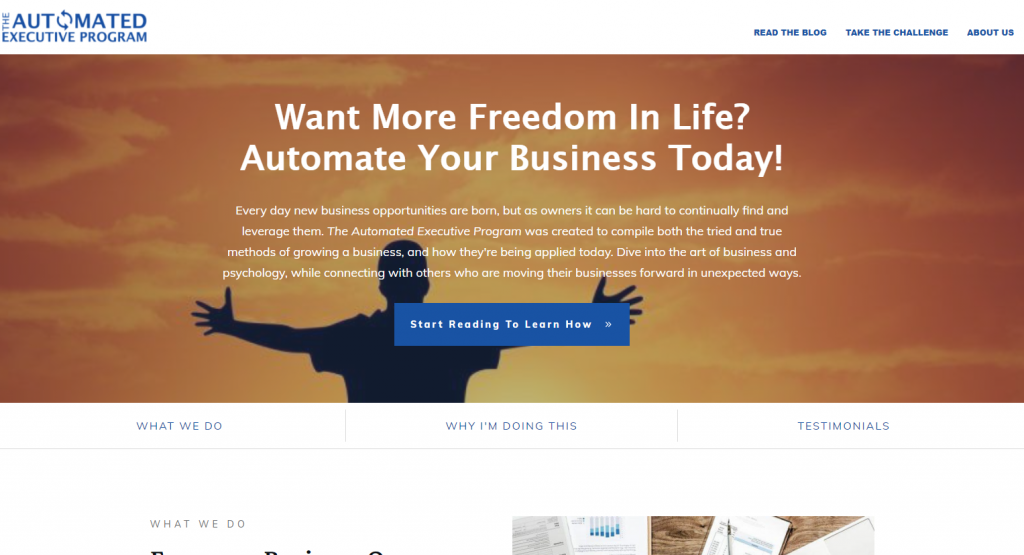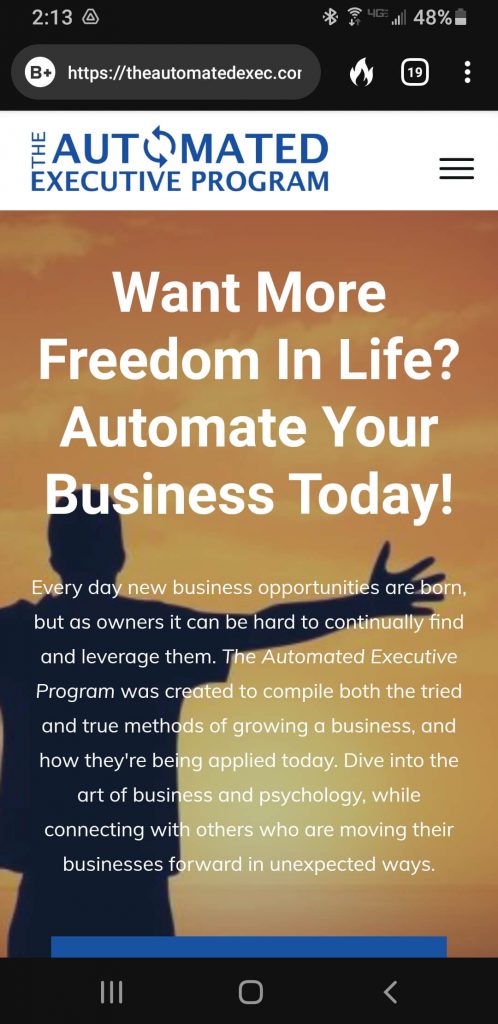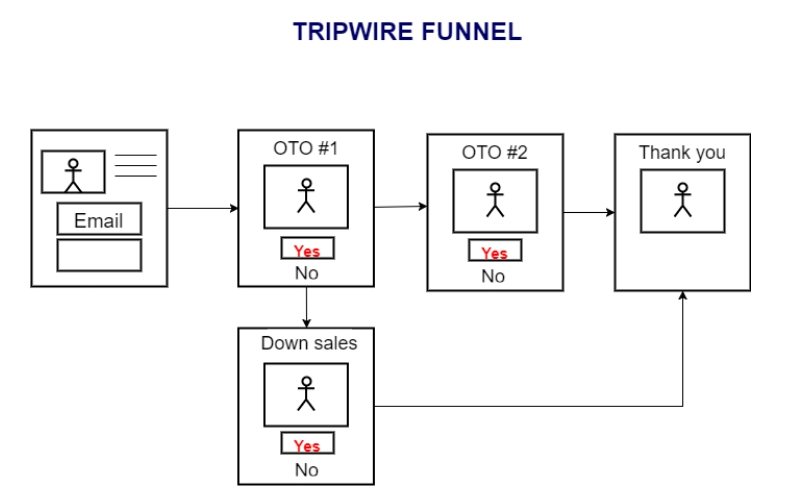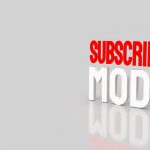Sales Funnels Are The Fastest Way To Get Your Audience To Move From “Prospect” to “Buyer”, But What Are They?
In our last post we talked about how a Website, particularly the Homepage, is your organizations’ “Window Display to the World.” Just like retail shops have window displays that capture the attention of people passing on the street, your homepage needs to capture the attention of visitors.
When the homepage captures their attention, then what? Well, this is where a Sales Funnel comes in. But what is a funnel, how does it differ from the website, and do you even need one? [Hint: 100%, Yes!]
When prospective buyers land on your homepage it’s imperative that everything they see “above the fold” immediately captures their attention and encourages them to keep scrolling. “Above the fold” simply refers to everything we see when first landing on a webpage. Of course, what we can see differs greatly depending on the screen size. Here is what visitors see on my site when viewing on a 27-inch monitor…

When viewing the same site on a phone though, the experience is much different given the extremely limited space. This is one reason why it’s so important to optimize every website and webpage for both desktop viewing and mobile viewing.

Headline = A “Hook”
After the logo and menu options at the top of the homepage, the very next thing they see is the headline. This headline needs to be deliver a powerful “hook” that commands the readers’ attention and ensures they continue reading.
The majority of visitors will decide in less than 10 seconds if they’re going to stay on the page or leave. Make sure your headlines are sensational enough they want to stay.
Want More Freedom In Your Life? Yes, who doesn’t?
Automate Your Business Today! Ok, how do I do that? I should keep reading.
Those were the hooks I used to entice you to stay on my site and make it this far down The Automated Exec rabbit-hole.
Tell A Story
The next part of the website needs to tell a story. What you do and for who (your mission), why are you doing this (your vision), and most importantly, exactly what’s in it for the audience.
“Story Selling” is one of the most effective ways to connect with an audience and convert them into brand advocates. It taps into the primal urge we all have to share our experiences.
Don’t get lost in features and the details of the products/service being offered. Instead, show folks you understand what they’re going through in life and business, you’ve been there, done that already, and they can benefit from those experiences.
Tell them what it’ll mean to join the group and become a customer and customers will thank you for taking their money.
A Strong Offer Is Critical For Success
Finally, end the page with what the audience will get, and exactly what they have to do to get it.
The “… what they have to do to get started” part is what’s called an offer and a “Call-to-Action” (CTA) usually in the form of a button. “Click Here”, “Sign Up Now”, “Complete Your Order”, and “Add to Cart” are some of the most common CTAs I’m sure you’ve seen around the web.
Russell Brunson, co-creator of Clickfunnels has lead the charge in recent years touting the “Hook”, “Story, “Offer” framework for how to build each step in a funnel. Every sales page needs a hook, story, then an offer (CTA).
Think of it like this – the only job of the headline is to get the viewer to read the next paragraph > the only job of the next paragraph is to get the visitor to click the button, or read the story below > the only job of the story below is to get the person to read the offer > the only job of the offer is to get the visitor to click on the CTA button.
Build your webpages like this and you’ll increase conversions.
Let’s breakdown exactly what’s in a traditional funnel so we can better understand what’s involved…
Funnel Building 101
Sales Funnels are exactly what they sound like – a path that guides customers down the specific buying journey they need to realize the greatest level of success with you.
Funnels are designed to breakdown the buying process so customers are given one product/service to focus on at a time. Once they agree to buying the first item – Your Core Offer – then they’re given the next complimentary product/service on the next screen, and so on.
Here’s an example of a very simple “tripwire funnel”. Tripwire refers to the idea that the initial offer is so amazing you practically trip over it.
I’ll use a famous story from marketing legend Perry Belcher. Perry was working with a client that sold suits to high net worth individuals.
Instead of asking customers to part with thousands of dollars on day one, he offered them something better – a funnel…

From left to right the funnel steps looked something like this:
- Tripwire: Offer the audience something small in exchange for their email address. Perry offered a pair of silver cufflinks in exchange for their email and just a few dollars. ($3)
- OTO #1: [OTO stands for One-Time-Offer] A silk shirt & tie combination that compliments the the person’s new cufflinks. ($99)
- OTO #2: A bespoke (custom) tailored suit, that included a car service to and from the tailor to ensure the proper fitting, and world-class experience. ($2,999)
- Downsell: If the person wasn’t interested in the shirt & tie combination, offer them the choice of just a shirt, or the tie at a discounted rate.
- Thank you page: No matter which steps the customer made it to in the process, be sure to shower them with congratulations at the end. It helps them avoid buyer’s remorse, while solidifying the relationship to make future transactions of any kind easier. (Note: Not all transactions are financial.)
That’s it, that’s a very typical Funnel in action!
2-5 highly specific webpages that guide the customer down the path to success.
Funnel Strategy For Success
Two things:
1. Did you notice how only one option was available in each step of the funnel?
Page 1: Cufflinks > Page 2: Shirt/tie combo > Page 3: A suit.
This focuses the audiences’ attention on the one thing they need to succeed at that point in the process.
If you have cufflinks but no French-cuff shirt then what good are they?
The cufflinks with the shirt and tie means a suit is the next logical thing they’ll need so sell them one!
Funneling customers through the buying journey means they’re presented with an offer exactly when they need it, are in a buying mode, and have a credit card in hand.

Another way to say it is, if you sell someone a nice pair of cufflinks but no shirt, tie, and suit it’s the same as saying you want them to be stuck at their next black-tie event naked and vulnerable. Don’t do that. Show the audience you care and sell them everything they need to own the room.
2. Did you notice how the dollar ($) amounts increased with each step as well?
There’s an old saying in marketing, “If you made just $1 with a product/service, you’ve won.”
$1 may not sound like a lot, but think about what it takes for someone to see a product, an ad, a website, or a funnel, then physically take out their credit card and buy something, and not return it days or even months later. The psychology behind that process is incredibly involved and some day we’ll dive deeper into it.
The most important part to know though is, once someone has spent that first $1 and accepted the purchase something that made their life better, there’s no limit to how much more they’ll spend with you. So long as they continue to perceive value from the products/services, of course.
Pay $3 and provide an email for a pair of cufflinks that could easily run $60, $70, or even $80 is an incredible deal.
$99 for a silk shirt and tie? I’ve spent more than that on a single shirt.
Even $2,999 for a car service to a bespoke suit is an amazing deal. You’d have to fly to Simpson Sin’s Tailor shop in Hong Kong to get a quality bespoke suit for that price. They go for about $800.
If you were wondering, Simpson Sin and the surrounding tailors are considered the Savile Row of Asia. Savile Row is where all the high end tailors in London are and suits run $10,000 and up, but I digress.
The point is, once someone’s made the decision to buy, it’s easier to get them to keep buying from you. They’ll also be willing to spend more and more as the relationship grows.
A “$200M In 6 Days” Funnel
This is how people like Tony Robbins gets 40,000 people to spend $5,000 to attend his 6-day virtual event, Date With Destiny (DWD).
[Did you do the math there? 40,000 x $5,000 = $200M. Yes, his funnel earns him $200M for 6 days of work.]
Of course, Tony’s been doing this for a few decades but his funnel looks like this…
He writes books ($15), that leads customers to buy an affordable course, or six ($132 each) that help folks find success in relationships, their career, love, etc. Those courses lead to events like Unleash the Power Within ($497), then Date with Destiny ($5,000). Finally, the finish line is his invite-only, private members club that costs around $100,000 per year.
That’s the power of a properly executed funnel, and they work for any business model, including yours!
Building A Funnel With Confidence
Ok, so what will your next funnel look like? What would be the tripwire? What’s the first one-time-offer, and the second OTO? Would there be a downsell?
Many downsells are simply they ability to pay in installments. When selling a $3,000 product and someone says “not right now”, give them the chance to pay 3 monthly installments of $1,100. This gives them the chance to act, while earning you an additional 10% in revenue. Win-win.
What if you have no idea of where to even begin building a funnel? No worries, there’s a strategy for that called – Funnel Hacking!
In his book, Dot Com Secrets, Russell Brunson talks about the strategy of “Funnel Hacking”. The concept is actually quite simple.
In every industry or niche there are usually a few companies that just dominate the competition.
Think, Apple, Nike, Gucci.
Who are the industry leaders in your niche?
Wouldn’t it be nice to carve out some of that success for your own business? You can!
Industry leaders usually have endlessly deep pockets, which means they’ve done the research as to what works and, more importantly, what doesn’t.
They’ve run the ads and found what messaging works and what doesn’t. In other words, they’ve failed just slightly less than they’ve succeeded.
Thankfully, the Internet has all the tools needed to research the competition to see what’s working for them, and then simply model it in your own business.
Start by actually going through their funnels. Buy the most popular products from their websites and take notes of everything you see. Then, model your own funnel from what you see. Back in the day this was called “Opposition Research”. Find out what the competition is doing right, then do it the same or better.
DO NOT, I repeat, DO NOT copy what they have. There are copyright laws in place for a reason, and plagiarizing is a surefire way to end up on the wrong end of a cease and desist letter, or worse.
But, use their proven funnels as inspiration for how to build yours’ with confidence knowing it’ll eventually convert prospects into buyers on day 1.
Remember To Launch, Launch, Launch
Once the funnel is built to model to other successful ones, next it’s imperative to make sure the world knows about it. Do that by Launching It! For more on that, check out this post.
Launching a funnel is critical to it’s success. Without launching the funnel it’s guaranteed to fail.
Why? Because it’s competing with other 1.5 Billion websites on the Internet. Unlike the Field of Dreams quote, “If you build it they will come.” I promise you, they won’t.
Launch the funnel, make as much positive noise about it as possible, and make sure your customers don’t show up to the gala naked without their cufflinks, shirt, tie, and suit.
So, what will your next funnel look like? Who’s the best competitor to hack and model from?
Tell us about it in the comments section below, then head on over to join the challenge!
Talk soon!
Sincerely,
Thomas Buttino – Funnel Hacker





